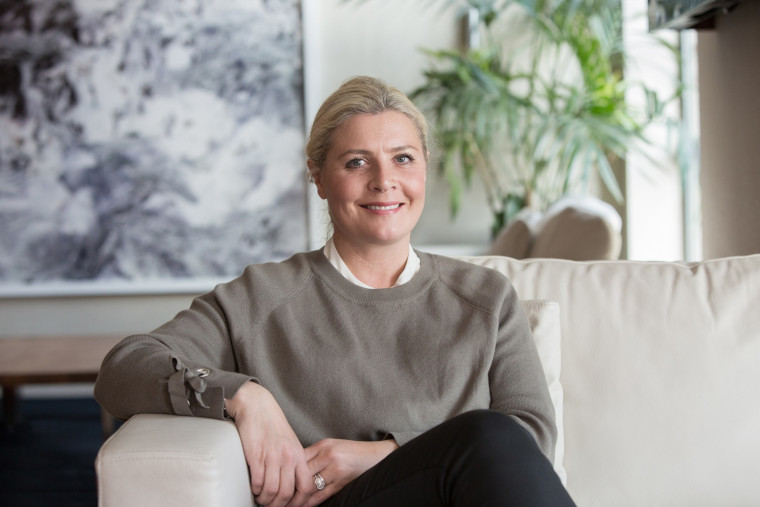Julia Bell, of Parapluie, outlines the complicated regulations associated with procuring paintings and sculpture and advises interior designers how to buy art
Tell me a bit about your background? I worked in the art world for over twenty-five years, mainly in public institutions and galleries but also in public art commissioning. I have extensive experience of working with artwork and sourcing art from artist studios, commercial galleries, art fairs and auction houses alongside knowledge of how to deal with all the issues surrounding owning art.
When did you launch Parapluie and why? I set up Parapluie in 2017 because I wanted to offer a range of client focused services that help people navigate the contemporary art world. The art world is incredibly opaque and it can be a daunting place, so I wanted to offer clients access to our expertise and empower them to make astute, confident decisions about buying and owning art. Over the last five years, I have not only advised individuals but increasingly interior designers and architects who also seek guidance and assistance with procuring and or commissioning art for their clients. Increasingly, they prefer to pass that responsibility to experts in the field for several reasons.

What are the common pitfalls that interior designers can fall into when buying art? Buying art isn’t the same as buying furnishings and fittings, it now has a lot more regulation around it and there are many pitfalls, some of which interior designers are not even aware of but which can have legal ramifications if they get the process wrong.
Art is now subject to anti-money laundering legislation. This means that if you procure art on behalf of a client, acting as a broker and negotiating the sale then you need to be registered as an Art Market Participant (AMP) with HMRC. This rule applies for any art transaction that is more than 10,000€ (or currency equivalent) including VAT. This figure could also apply even if you purchased say three artworks each individually priced less that 10,000€ in one transaction, but which make up this threshold figure as it will be considered as one sale.
The AMP rules apply to interior designers, even though this is not widely known. So, if interior designers are acting in this capacity, they need to register with HMRC, undertake annual training for all staff who procure art for clients and company directors involved in the business, have policy documents in place and pay annual fees to HMRC. Their customers who make acquisitions totalling 10K+ € will need to complete an annual Know Your Customer check, for example by providing photo ID and proof of address as part of the interior designer’s Customer Due Diligence process and each art transaction logged against these records. They also need to run checks on the commercial galleries they are sourcing the artwork from. It’s a lot of work to add to a process when it is not your core business and if compliance isn’t adopted, interior designers can be subject to an HMRC intervention and fined.
Another pitfall is when procuring art from commercial galleries for clients, interior designers are not aware of the resale issues that some galleries stipulate. Often these terms and conditions are in fine print on the back of an invoice and often go unnoticed. They may stipulate that the gallery has first refusal on any resale of the artwork purchased, some even state that a condition of sale is the artwork cannot be resold within a specific period. This is to avoid something called flipping where artists’ work goes too quickly back onto the market and damages their value. The commercial gallery world is very protective of its artists in what is one of the few remaining unregulated markets, if this happens, often the person procuring the artwork, or the owner of the work will be blacklisted from buying work in the future from the gallery.
Related to this matter is the process where interior designers buy work off a gallery and then sell it onto their clients often with a percentage added on top. What they are doing is effectively acting as a dealer. A dealer buys and resells art and a dealer is also subject to anti-money laundering regulations as an art market participant. They are also acting as the primary owner of the work and in effect placing the artwork into the secondary market immediately by selling it onto their client. They too could be subject to the terms and conditions of sale that a commercial gallery might stipulate as condition of sale if the invoice is made out to them as they are signing those T&Cs.
In addition to this, provenance of artwork seems to be something many interior designers are not familiar with and just how important it is to be aware of the legal issues related to this particularly if designers are procuring art from secondary market dealers and galleries or auction houses. You need to know the history of ownership of that work and be confident that it has always changed hands legally, nobody wants to be accidentally involved in brokering a sale that involves stolen artworks. It should also be noted that secondary market sales are also subject to anti-money laundering regulations, particularly because the risk of money laundering is considerable in previous sales transactions.
As more interior designers become aware of this compliance and the nuances of the art market, they recognise the need to get specialist support or outsource the work to art advisors who are registered as AMPs and are familiar with managing this process on behalf of them and their clients.
Other issues that interior designers are often not aware of are the maintenance and care of artwork and the suitability of artwork for locations. Some artworks require protection from direct sunlight, humidity, extreme changes in temperature, household pests, or the general day to day traffic within a space. Art that works in one space might not be suitable for another and a lack of knowledge often results in decisions on artwork that are impractical and create problems for the future. There is also a lack of knowledge on the import and export of artwork and the associated implications that we can offer guidance on, plus access to a team of trusted associated who are experts in this area.
What service do you offer to interior designers? Parapluie is an art advisory service with a global reach, specialising in the international sourcing of exceptional art, so we can offer a full 360 service to interior designers and their clients.
We are registered with HMRC as an Art Market Participant so we can deal with all the legal process of procuring artwork that complies with anti-money laundering legislation. We ensure that both the interior designer and their client are legally compliant. We also ensure that all the legal paperwork, title of ownership and any terms and conditions of purchasing artwork are clear and that the client understands what they are buying and the terms of the sale. We oversee the entire process of sourcing artwork for our projects, from negotiations with artists, galleries, at art fairs and auction houses, through to transport, delivery, and installation. We can also share our expertise at the earliest stages of architectural and interior projects to inform designers’ approach to designing spaces that can accommodate art taking into consideration technical installation, environmental conditions and long-term care and maintenance, all of which need to be considered when planning for and selecting works of art.
We also offer a handling and re-hang service, or the removal, transportation, and re-installation of artwork into new interior settings and advise on art storage and valuation during renovation periods.
Do you specialise in contemporary art? How do you choose the artists and galleries you work with? We mainly source modern, postwar and contemporary art for clients, although we can connect clients to specialists in other areas. I base my decisions on artists and galleries by spending a considerable amount of time researching the art market and the art world. There are some excellent emerging artists who show real promise who I like to support if a client has a lower budget to spend but wants to know they are buying good art by promising artists.
Conversely, I also like to propose artists who are represented by good galleries, with strong trajectories and have a bright future ahead internationally or have already established their career. Fundamentally a client needs to love the art they are buying, but it is always nice if there is a chance that the purchase might also have investment potential. It is never something I guarantee, but if an artist has all the right markers of value and is gaining traction and recognition then the right foundations are in place. We also protect clients from being pressurised into purchasing overpriced work.
What is your favourite possession? My dog! He can make anywhere feel like home.
If you enjoyed this interview, you may like Verity Woolf’s feature on incorporating art into an interior scheme. Click here



